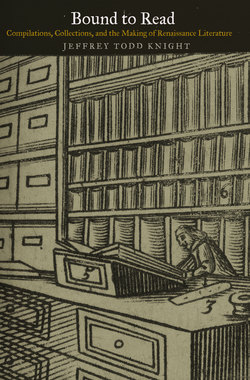Bound to Read

Реклама. ООО «ЛитРес», ИНН: 7719571260.
Оглавление
Jeffrey Todd Knight. Bound to Read
Отрывок из книги
Bound to Read
A complete list of books in the series is available from the publisher.
.....
AB.8.46 is a related example, formerly containing two Caxtonian saints’ lives bound with sixteenth-century literary works by John Skelton, John Rastell, and Henry Medwall.57 Pugh’s entry and its supplementary annotations indicate that the volume was reshaped twice by modern librarians: once to extract the incunabula and a second time to separate out the remaining early printed books to make them borrowable.58 Another volume, AB.4.59, once comprised eleven texts bound together, all issuing from Wynkyn de Worde’s press. But because the volume’s final item, The Meditacyouns of Saynt Barnard, was printed in the earliest part of de Worde’s career, in 1496, all of the items had to be disbanded and set into proper order in Bradshaw’s modern library. The first ten texts now form individual books in Bradshaw’s “Sel.” class, while the final item was rebound and reclassed as an incunabulum.59 Numerous early compilations in the AB catalog straddle this 1500 divide; their reorganization highlights its centrality in determining the shape of archives, separating print (and modernity) from what came before. AB.4.54, for example, was a compilation of four books, two literary and two nonliterary, printed between 1499 and 1503: Petrarch’s Bucolicum carmen (1502), Maximianus’s Elegiae (1503), the incunabulum Orationes Philippi Beroaldi (1499) on the topic of Cicero, and Solinus’s geography De memorabilibus mundi (1503).60 The texts were numbered in their former position by a sixteeenth-century owner—“primus,” “secondus,” and so on—who also used the blank spaces in the volume to record fragments of other texts that interested him, as one might use a notebook or a commonplace book.61 Despite the fact that these books were printed within a few years of one another and evidently used in close intellectual or physical proximity, the volume was split into individual units, its parts decontextualized and set into the correct categories: “book” or “incunable,” but never both.
Less arbitrary perhaps, the line separating print from manuscript was another important factor in the reform of the AB collection. As Harold Love, Arthur Marotti, Henry Woudhuysen, and others have demonstrated, the distinction between the two categories of text was never as absolute in the early modern era as it is in modern culture.62 The transition from one medium to another as the dominant mode of textual and literary circulation was gradual, and in production, especially in the Renaissance, they often overlapped. Indeed, Pugh’s catalog lists several examples of composite books that contained both printed and manuscript material, specimens later deemed hybrid or composite as the categories came into use and finally disbanded by the university librarians. AB.10.54 formerly contained three printed books—a history of Jason, a poetic work on the subject of death, and a later production of The Myrrour of the World—along with a manuscript copy of Sallust’s monograph on the Cataline conspiracy written in a neat sixteenth-century hand.63 The works contain matching ownership inscriptions and marginalia, but the handwritten portion was extracted, rebound, and transported to the manuscripts department at Cambridge in the nineteenth century.64 Moreover, because two of the three printed texts were incunabula, the remains of the composite volume were themselves disbanded and reorganized into individual units in their proper categories. Another example is AB.10.57, which once contained seven books now separate—four manuscripts and three early printed texts, all related philosophical works.65 According to a note in the AB catalog dated 1799, the manuscript material was extracted and given its own binding during Pugh’s tenure. And later, in the nineteenth century, the volume was reconfigured yet again to make its printed contents into individually bound modern books.
.....